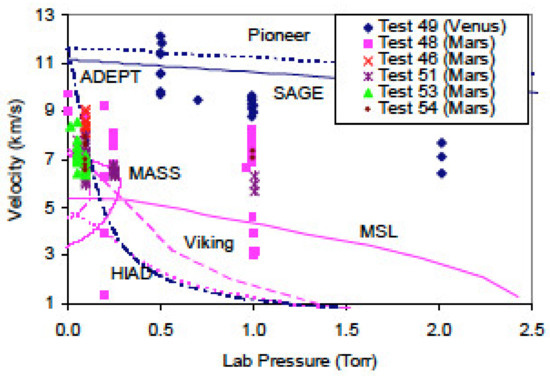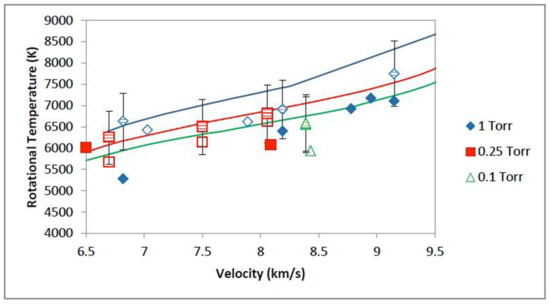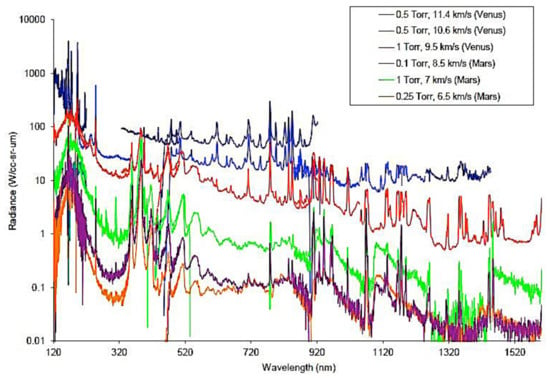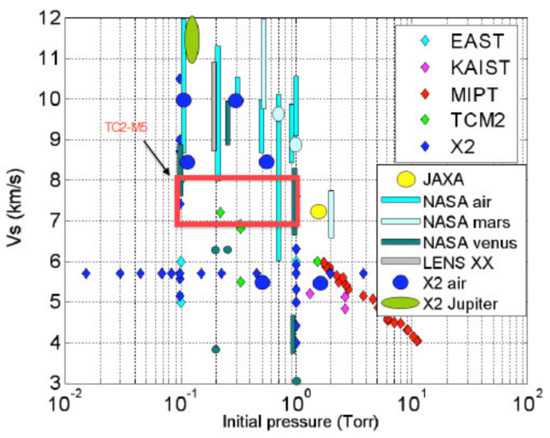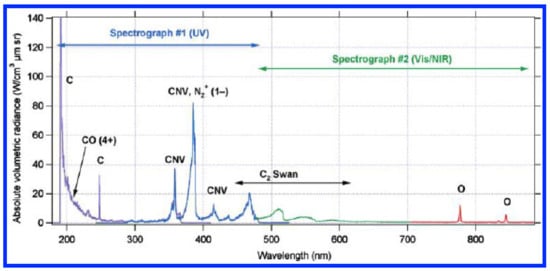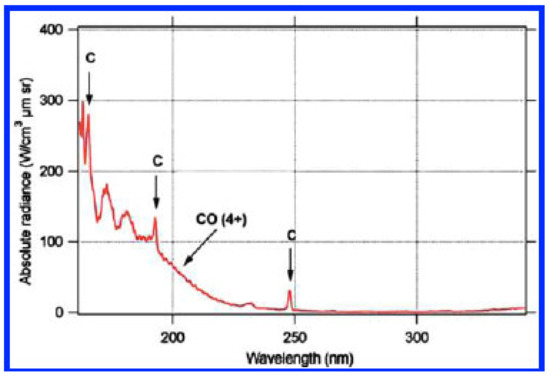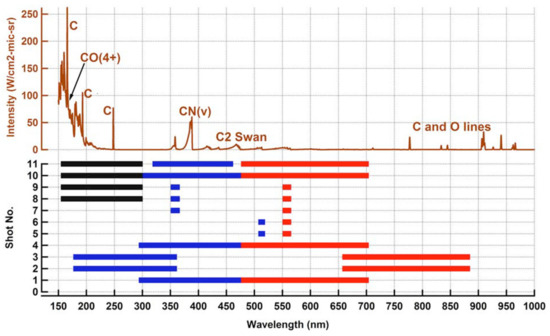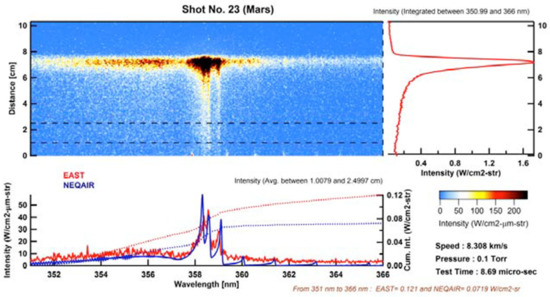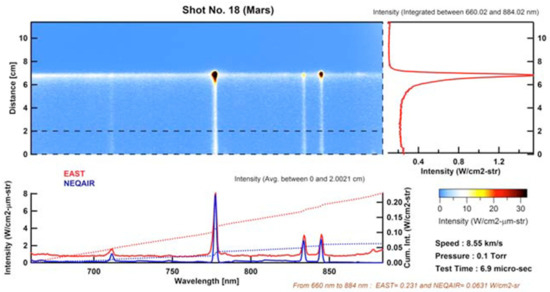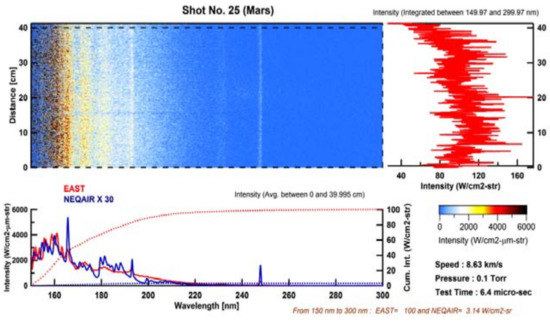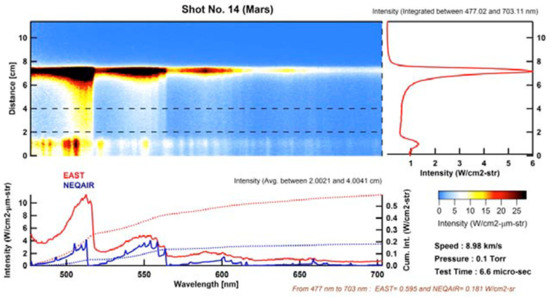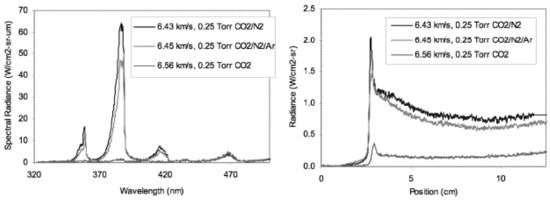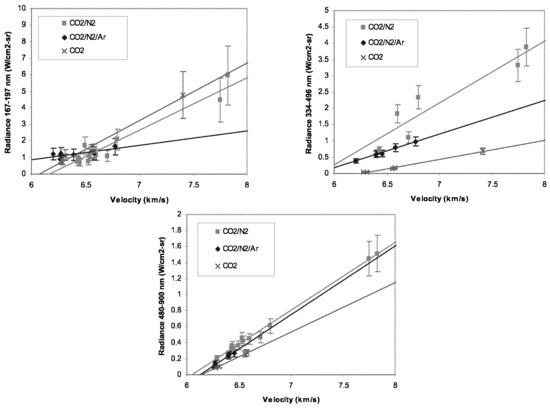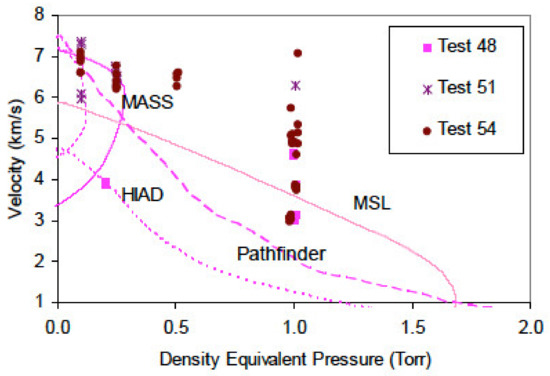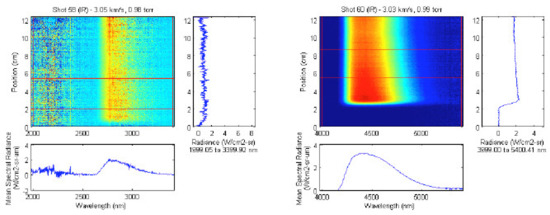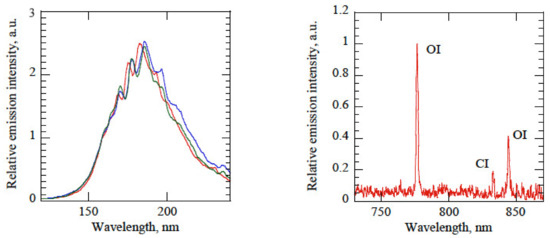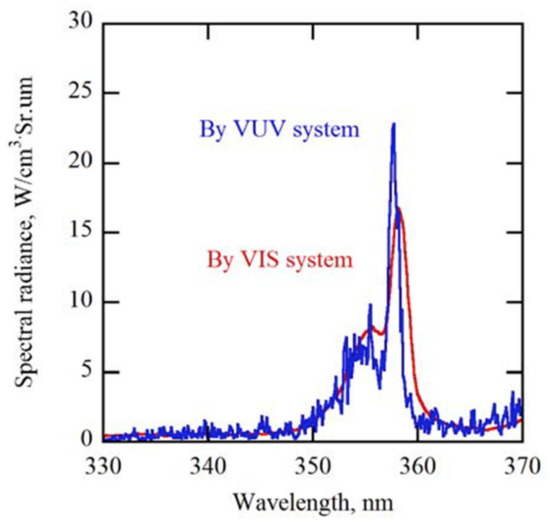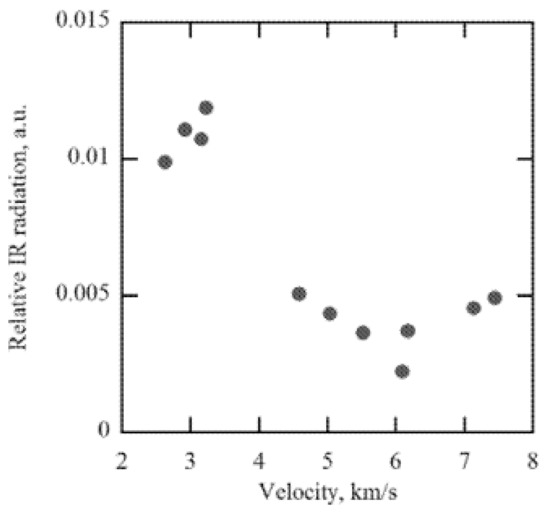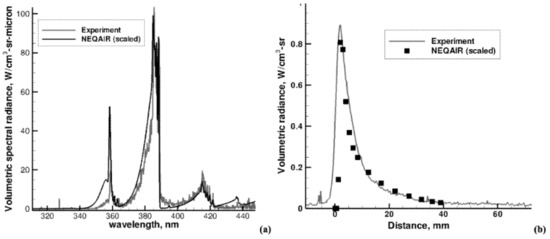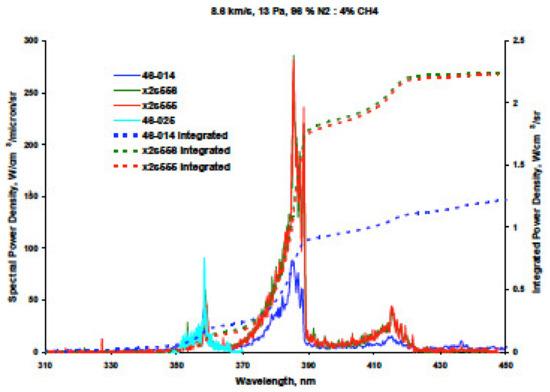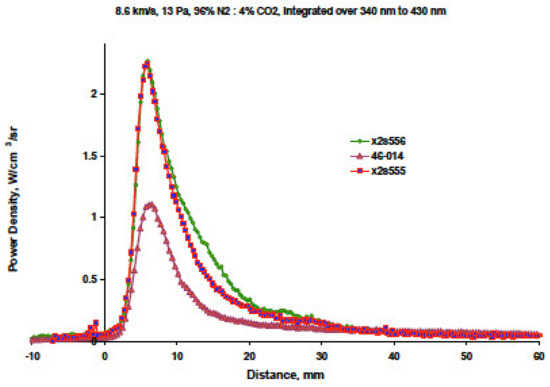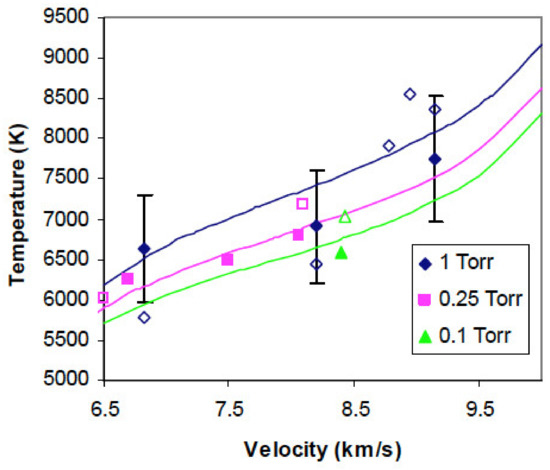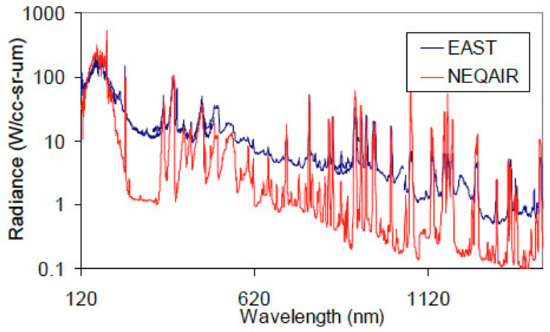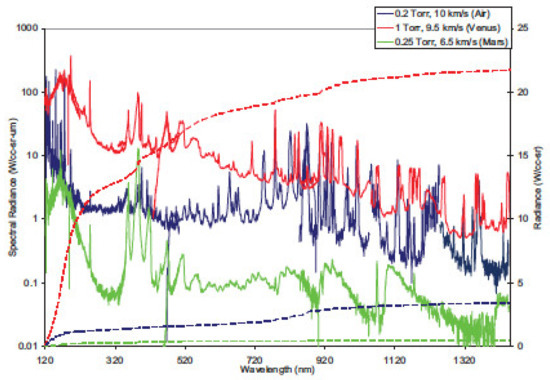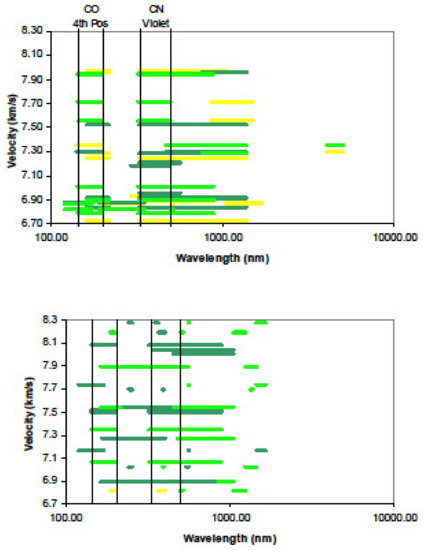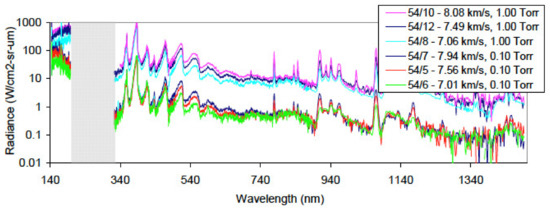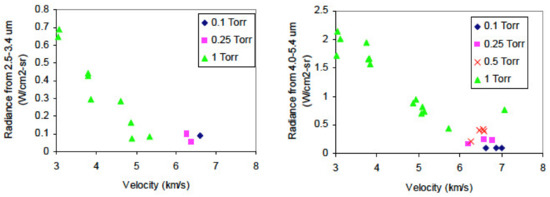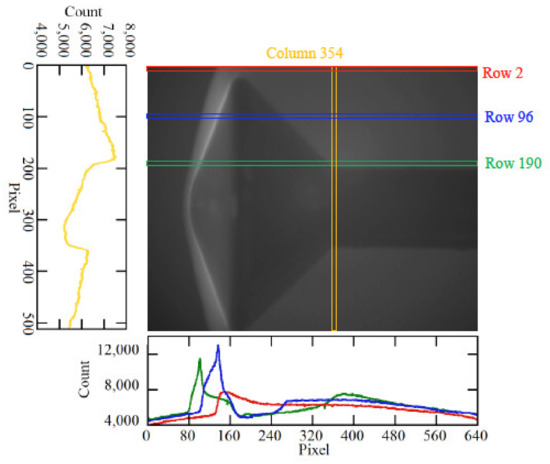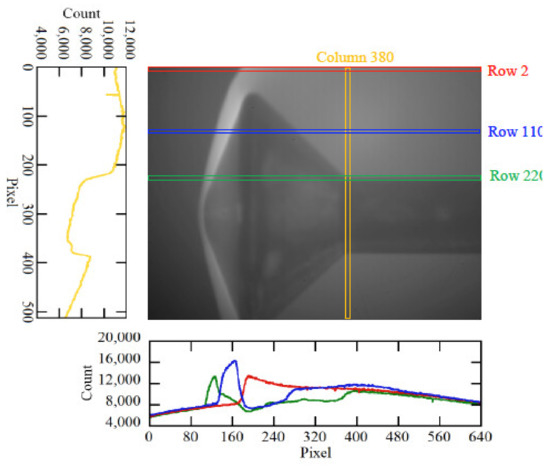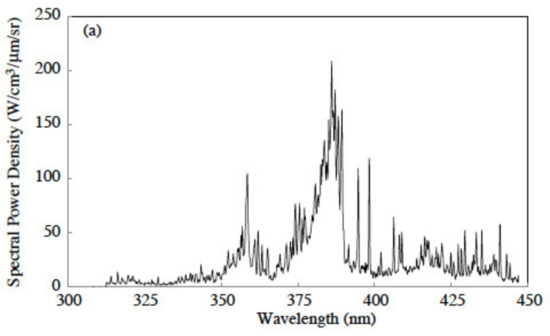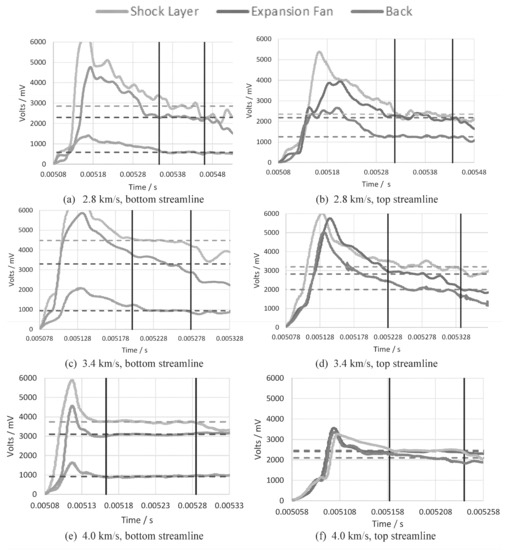4.2. Available Datasets
The study carried out by Martinez [1] focuses more particularly on CN, and C 2
and their related rotational temperatures. The results obtained for the rotational temperature as function of the shock velocity are displayed in
. They highlight the increase of the rotational temperature with the shock velocity. The spectra from 120 to 1520 nm, obtained by Martinez [1] for both Mars aerocapture, at 6.5, 7, and 8.5 km/s, and Venus entry conditions, at 9.5, 10.6, and 11.4 km/s, are shown in . Datasets cover VUV up to NIR radiation, with the major contribution in the VUV. The VUV range is dominated by the CO(4+) system, two carbon atomic lines are also present at 193 and 248 nm.
Figure 8. Rotational temperature for CN and C2 systems (from
[1]).
Figure 9. Mars and Venus spectra obtained in
[1].
Other test campaigns for Venus entry conditions (3–12 km/s 0.1–2 Torr) were conducted in EAST [11][12] spectral radiance was investigated from VUV through mid-IR (120–1650 nm, and 3000–5000 nm). Tests conditions are plotted in
Other test campaigns for Venus entry conditions (3–12 km/s 0.1–2 Torr) were conducted in EAST [17,18] spectral radiance was investigated from VUV through mid-IR (120–1650 nm, and 3000–5000 nm). Tests conditions are plotted in . Resolved spectra of the CO 4
th
positive band in the VUV was also reported for the first time. Measurement of CO
2
molecular vibrational radiation was also attempted for low velocities. The contributions of the different spectral regions from VUV to IR, to the total radiance for Venus and Mars entry conditions are resumed in
. Mid IR was only investigated at low velocities (3–4 km/s). For the other measurements medium resolution imaging was performed for C
2
Swan, CN Violet, O 777 nm triplet and C 193 and 248 nm lines.
Figure 10.
Contributions to the different spectral regions to the total radiance for different Mars (96% CO
2
, 4% N
2
) and Venus (96.5% CO
2
, 3.5% N
2) entry conditions [11].
The observed results are similar to those reported in [1] that can be seen in . One of the main radiator is CN radiating 22% less in Venus mixture than in Mars mixture, all other parameters being equal.
The analysis of the different tests shows that below 10 km/s, there is a strong emission from 120–300 nm, due to the CO 4th positive system reaching a maximum at 160 nm, this is the dominant feature in the spectrum. Other major contributors to radiation emission are, NO, strong atomic lines of C, O, and N, and CN Violet, with the four bands at 359, 388, 422, and 461 nm, corresponding to CN Violet system. The radiation intensity emitted by the CN Violet system, increases with the velocity up to 10 km/s, then decreases and vanishes, since the energy present in the flow is sufficient to dissociate the molecule. Swan band for C
2
, in between 500 and 700 nm, is also present in
, but at a much weaker level than CN. Like for CN, C
2
contribution disappears above 10 km/s due to dissociation effects. The same phenomenon applies to the CN red system, which is strong in the NIR above 700 nm below 9 km/s and vanishes when the shock velocity increases. With the increase in velocity, the atomic lines become visible, as highlighted in
, with the oxygen atomic triplets at 777 and 1130 nm, and the C atomic lines and 193, 248, and 1069 nm. However, the main features when increasing the velocity is the growth of the background continuum radiation certainly due to interactions between the electrons and atomic and molecular species that include free-bound and bremsstrahlung processes.
The contributions to the total radiance for different wavelength bands have been computed by Cruden et al. [11] and are shown in
The contributions to the total radiance for different wavelength bands have been computed by Cruden et al. [17] and are shown in . The first contribution for all pressures and velocities is from VUV to far UV wavelengths, in between 125–215 nm, with 45 to 58% of the total radiation. At these wavelengths the radiation is mostly produced by the CO 4th positive system and from NO. The IR radiation above 900 nm is small with around 10 % of the total radiation. The radiation in the visible domain can be mainly attributed to the CN red system. The region in between 330 and 480 nm, contributes to 35% of the total radiation at 6.5 km/s. This strong contribution decreases at higher velocities, with 12% at 11.5 km/s due to the dissociation effects that are strong. Radiation from C
2
Swan, 480–700 nm is for the different cases lower than 10% of the total radiation.
Measurements of C
2
and CN bands systems have been used to compute rotational temperature; corresponding results are plotted in
. Finally, the tests have been reconstructed with NEQAIR [13]. Comparisons between experimental data and numerical calculations for different spectra are shown in
. Finally, the tests have been reconstructed with NEQAIR [19]. Comparisons between experimental data and numerical calculations for different spectra are shown in ,
and
.
shows the comparisons between EAST data and NEQAIR calculations, of the integrated radiance from carbon lines and oxygen triplet, for the different studied conditions.
Figure 11. Rotational temperature for Venus and Mars conditions
[11][17].
Figure 12. Comparison between EAST data and NEQAIR for Venus entry at 1 Torr and 9.5 km/s
[11][17].
Figure 13. Comparison between EAST data and NEQAIR for Venus at 0.5 Torr: a) VUV spectrum at 11.4 km/s; b) VIS-NIR spectrum at 10.5 km/s; c) NIR spectrum at 11.4 km/s
[11][17].
Figure 14. Integrated radiance from carbon lines (193 and 248 nm) and oxygen triplet (777 nm) (EAST experimental data as solid points; NEQAIR calculations as lines)
[11][17].
Radiation emission spectra from VUV to mid-IR for Earth, Venus, and Mars entry conditions have been compared in
[14][20] they are plotted in . In the same contribution, Cruden
[14][20] has provided extensive details on the calibration of the different measurement techniques used for the test campaigns including the deuterium and mercury lamps for VUV and UV-VIS measurements respectively. Mercury lamp is used for spectral calibration using atomic line sources in UV-VIS, in the infrared, typically, Hg lamps are used for the same finality. For calibration below 300 nm, a deuterium source is frequently used; other options are possible (H
2 or Ar arc lamps, Xe lamps, or hollow cathode discharges). Lamps are thermally driven, and as they are limited by the Planck curve they generally do not get hot enough for short wavelength ranges characteristic of V, and VUV radiation.
Figure 15. Equilibrium radiation spectra and total radiative flux (dashed lines) for Earth, Venus and Mars entry conditions
[14][20].

